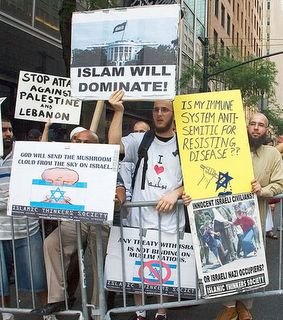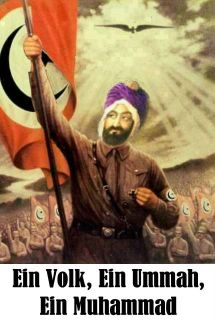Fissile materials have a characteristic critical mass at which a chain reaction becomes self-sustaining. Similarly, it appears that non-Muslim societies with growing Muslim populations reach a "critical mass" at which the slide into Islamic law -- and the attendant brutality, poverty, and conflict -- becomes inevitable.
Islam is an aggresively proselytizing faith, placing a premium on gaining believers and eliminating non-believers, either by conversion, coercion, or war. People are free to convert
to Islam but conversion
from Islam is punishable by death. So what's the appeal? Islam's ferocious certainty can provide self-confidence to the insecure, a sense of identity to the isolated, or meaning to the spiritually adrift. The five pillars of Islam emphasize not the supremacy of God, but of Islam and Muslims. And the unofficial sixth pillar, jihad, mandates war against infidels until they convert, submit, or die.
The result is that societies rapidly succumb to aggressive Muslim minorities, initially becoming "Islamic" despite a non-Muslim majority. Once Islamic law is in effect, non-Muslims can be persecuted, bankrupted, coerced, blackmailed, killed, and otherwise driven out. Countries can be classified into 3 general categories, tending to move from one to the next as Muslims assert increasing dominance:
1. Secular; zero or neglible numbers of Muslims
2. Transitional; a substantial minority of Muslims, and a high level of conflict.
3. Islamic; approaching 100% Muslim.
These are roughly equivalent to the three categories recognized in Islamic law: Dar al-Sulh (land of truce); Dar al-Harb (land of war); and Dar al-Islam (land of peace).
So I got to doing a little number-crunching (source:
CIA World Fact Book). Of the 57 nations of the Organization of the Islamic Conference, 8 have a small proportion of Muslims : Benin (20%), Cameroon (20%), Gabon (less than 1%), Guyana (10%), Mozambique (18%), Suriname (20%), Togo (20%), and Uganda (16%). How, exactly, these states came to belong to an expressly Muslim trade and security bloc -- Gabon, in particular -- would be an interesting question to research.
Of the remaining 49 member states, 29 are almost completely homogenous, with Muslims comprising 90% or more of the population. In another 8 OIC countries, Muslims make up over 80% of the population.
The remaining 12 members of the OIC have Muslim populations between 20-70%; many are familiar as sites of perpetual violence. In at least some of these countries, authorities are actively working toward 80-90% Muslim majorities, which is often the cause and purpose of the violence. Sudan is an excellent example. The only theological debate over genocide in the name of Allah is whether it is permitted or required.
Other countries with small Muslim populations are also familiar as jihad epicenters: The Philippines (5%), Thailand (4.6%), India (13.4%), The Netherlands (5.5%), UK (2.7%), France (5-10%), and Russia (10-15%).
This is not to say that Islam is the
only source of violence in the world. But there is certainly a strong correlation; and it's not inaccurate to say that Islam is the primary or most widespread source at this point in history. Whether a non-Muslim country becomes Islamic or not likely also depends on the strength and skill of the resistance. But it seems that generally, a fairly consistent figure -- a Muslim population somewhere above 10% but below 50% -- is the tipping point on the road to shari'a. The good news is, a considerably higher proportion seems necessary before flat-out genocide begins.
I'll keep crunching the numbers; in the meantime, please see the
Bloody Borders Project for more.




 Lan Astaslem/I Will Not Submit
Lan Astaslem/I Will Not Submit